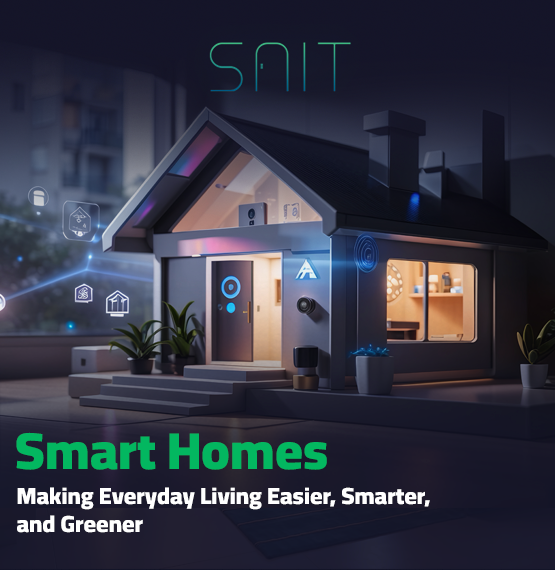Imagine walking into your home after a long day, and without lifting a finger, the lights dim to your favorite setting, the thermostat adjusts to the perfect temperature, and your favorite playlist starts playing. Sounds like a scene from the future, right? Thanks to AI and smart home technology, this is already happening today.
The way we interact with our homes is changing fast. Home automation used to be about basic tasks like switching lights on or off. But with AI-powered smart control, our living spaces are now becoming intelligent partners that adapt, learn, and even anticipate our needs. This shift isn’t just about convenience, it’s about creating homes that are energy-efficient, secure, and perfectly tailored to our lifestyles.
The Rise of AI in Smart Homes
At first, smart home devices were pretty simple. You could program a thermostat or set a timer for your lights. But with the rise of AI, things got a lot more interesting. Today, these devices can actually learn your habits and make smart choices on their own.
Take a smart thermostat, for example. Instead of you constantly adjusting it, AI can learn your daily routine. It knows when you usually leave for work, when you get home, and when you go to bed. Using that data, it makes temperature adjustments automatically — saving energy while keeping your home comfortable.
And it doesn’t stop there. With technologies like machine learning and natural language processing, your smart devices don’t just follow commands — they understand you. Voice assistants like Alexa, Siri, and Google Assistant are perfect examples. They use AI to make everyday communication with your smart home as easy as talking to a friend.
Meanwhile, the Internet of Things (IoT) connects everything together. Your smart fridge can talk to your oven, your security cameras can talk to your smart locks, and your blinds can work with your thermostat. This level of smart control creates a seamless, connected experience where devices work together to make your home truly intelligent.
Smarter Convenience and Efficiency
One of the biggest perks of AI in smart homes is how much easier it makes life. Imagine never having to worry about leaving the lights on or wasting energy heating an empty house.
With smart touch and smart control, routine tasks just happen. Lights can adjust brightness depending on the time of day or whether someone’s in the room. AI thermostats can look at the weather forecast and automatically optimize heating or cooling. The result? A comfortable home that also saves on energy bills.
Even kitchens are getting smarter. AI-enabled refrigerators now track expiration dates, suggest recipes, and even let you peek inside from your phone. Smart ovens can be preheated on your commute home and cook dinner to perfection. It’s like having a kitchen assistant who knows exactly what you need.
Personalization Through AI
What makes an AI-powered smart home truly special is how it adapts to you. Instead of one-size-fits-all automation, smart control creates a personalized environment.
Think about entertainment. AI-powered smart speakers can create playlists based on your mood or recommend shows you’ll love based on your viewing history. Over time, they get better and better at predicting what you want.
Security is also smarter. AI cameras can recognize familiar faces and tell the difference between a family member and a stranger. If unusual activity is detected, your smart home instantly alerts you. This isn’t just security, it’s personalized peace of mind.
Even your garden can benefit. Smart irrigation systems use AI to water plants based on weather and soil conditions. That means healthier plants and no wasted water.
Health, Comfort, and Well-being
AI in home automation isn’t just about gadgets, it’s about creating a healthier and more comfortable environment.
For example, smart air purifiers can monitor air quality and adjust automatically to remove pollutants or allergens. That’s a game-changer for anyone with allergies or asthma. Meanwhile, smart devices can also monitor humidity levels and keep your home comfortable year-round.
Sleep technology is another exciting area. Smart sleep trackers can analyze your sleep patterns and work with lighting and thermostats to create the perfect sleep environment. Imagine lights that gently dim when it’s time to wind down, and a thermostat that keeps your bedroom at the ideal temperature all night.
And with wearables syncing to your smart home, you can track vital health data like heart rate, stress levels, or activity. Your home can then respond with personalized suggestions — whether it’s adjusting the lighting for relaxation or reminding you to take a walk.
Challenges to Consider
Of course, no revolution is without challenges. With so much data being collected, privacy and security are major concerns. Homeowners need to make sure their smart devices and networks are secure to avoid risks.
Another issue is dependency. With smart touch and smart control running so many tasks, it’s easy to forget how to do things manually. Balance is key, letting AI simplify life while still staying in control.
And then there’s compatibility. With so many brands and ecosystems, not all smart devices work together smoothly. Industry standards are improving, but this is still a hurdle for many homeowners.
The Future of Smart Living with AI
Looking ahead, the possibilities are endless. With AI, smart homes will continue to get more intuitive, more connected, and more sustainable. Emerging tech like edge computing and 5G will make devices even faster and more responsive.
We may even see fully autonomous homes, spaces that run themselves, anticipate our needs, and adapt in real time. From smart control of energy use to AI-driven health monitoring, the future home will be more than just a place to live. It will be an intelligent partner in daily life.
Final Thoughts
AI is redefining what it means to live in a smart home. Through smart touch, smart control, and AI-powered devices, our living spaces are becoming personalized, efficient, and healthier than ever before.
Yes, there are challenges like privacy and compatibility, but the benefits far outweigh the drawbacks. From cutting energy costs and boosting security to improving well-being, the impact of AI in home automation is massive.
The bottom line? Smarter living isn’t just about technology, it’s about creating homes that truly understand us. And with AI leading the way, the future of smart homes looks brighter than ever.
Frequently Asked Questions (FAQs)
What makes a smart home different from a regular home?
A smart home uses AI and connected devices to automate daily tasks like lighting, temperature, and security. With smart control and smart touch, your home can adapt to your lifestyle and even anticipate your needs.
How does smart control improve daily living?
Smart control allows homeowners to manage devices automatically or with simple commands. For example, a thermostat can adjust itself based on your routine, while lights can dim or brighten depending on the time of day, all without manual effort.
What role does smart touch play in a smart home?
Smart touch provides an intuitive way to interact with devices, such as touch panels for lighting, temperature, or entertainment systems. Combined with AI, it creates a seamless experience where your home responds instantly to your preferences.
Can AI-powered smart homes help save energy?
Yes! AI-driven smart home systems learn your habits and optimize energy use. From adjusting heating and cooling to preventing lights from being left on, smart control reduces waste and lowers energy bills.





